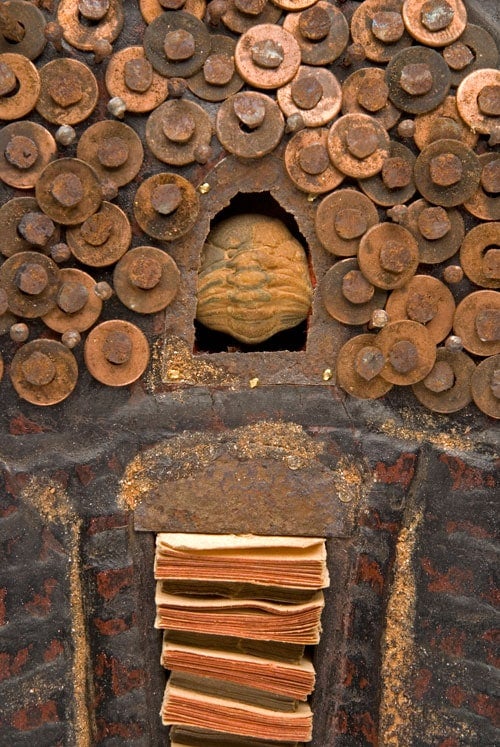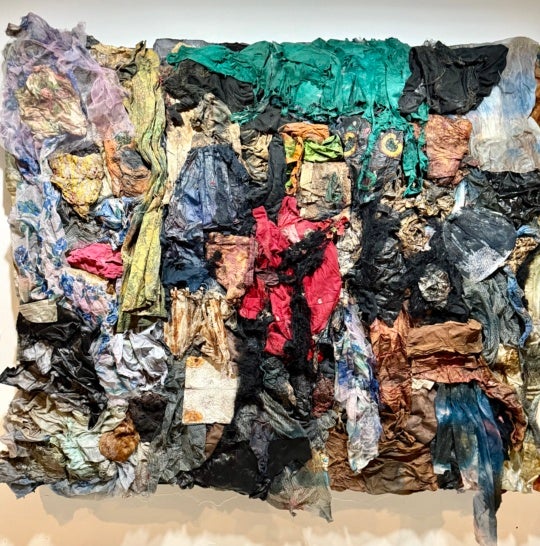
Tops Gallery in Memphis is a great place to experience Marja Vallila’s ceramic sculptures. Their glossy, polychromatic surfaces are well lit and provide a striking contrast to the gallery’s neutral tones. Located on the industrial, south side of downtown Memphis, Tops is in the basement of a repurposed warehouse. After navigating down several wooden steps and through a dark, underground art storage and studio space, visitors encounter Tops truly as the light at the end of the tunnel. Roughly cut from the exposed concrete walls, the cavelike archway into the main gallery provides a dramatic frame for the pedestaled sculptures beyond, as if the space were made for them. Illuminated by both fluorescents and sunlight (the latter pouring in from an open manhole in the ceiling), the installation is vertically flanked by the gallery’s white floor and ceiling. The surrounding materials together point to a classic narrative—the harmonious cohabitation of the organic and the human-made. Vallila’s bizarre yet familiar forms, however, simultaneously reinforce and renew this theme in their traditional ceramic medium and their curiously decorated and polished exteriors.
Vallila’s Late Works, on view at Tops through November 11, were created between the years 2000 and 2004, after Vallila visited the Museum of Ceramics in Deruta, Italy, although the medium was not new to her then. Born in Prague in 1950, Vallila later settled in Washington, DC, and received an MFA from Cornell University. For over 25 years, she taught art and design at the University at Albany – SUNY, during which she was a prolific maker of large-scale outdoor sculptures, primarily welded of mixed metals, slowly evolving over time to include smaller works and a wider variety of mediums. Today, she lives in Memphis.

In 2004, Vallila was diagnosed with frontal lobe dementia, a disease that people are thought to suffer from years before their diagnosis. According to her daughter Petra Vallila-Buchman, Vallila may have been experiencing the early effects of dementia while creating this, her most recent, body of work. Until this year, it had not been shown to the public since 2004 in New York. Just last year, Tops Gallery director Matt Ducklo met Vallila’s former spouse, sculptor James Buchman, who had been storing the remarkable ceramic works at his Memphis home. Thus, the idea for Marja Vallila: Late Works was planted.
Late Works was shown earlier this year at Atlanta Contemporary in a small gallery dedicated to artist-run spaces in the Southeast, where 11 of Vallila’s sculptures were crowded onto a single shallow plinth, preventing a clear, in-the-round viewing of individual works [read our review]. At Tops, 15 of her sculptures are displayed separately, each on its own pedestal, with plenty of space between for visitors to see every angle comfortably, up close, and unobstructed.

In the main gallery, five sculptures measuring 10 to 15 inches high are displayed on tall plinths in the center of the room, easily within the standing viewer’s line of sight. Two smaller sculptures sit atop wall sconces toward the back of the room. There are no text panels in the installation to inform of titles, dates, dimensions, or artist’s statement, which allows viewers to develop untainted interpretations of the work, but makes Ducklo’s commentary almost necessary to gain contextual knowledge. As a whole, her elaborate sculptures are composed of repeating shapes that vaguely resemble something between an organ of the human body and an ornamental teapot. Found objects and her own slip-cast creations are mixed and stacked (usually) vertically so that bulbs, hooks, and rings protrude from the sides evenly yet unexpectedly. Glazes are multicolored, ultra-shiny, and sometimes speckled or metallic.

Four monochromatic sculptures are mounted in a row on the opposite wall, from left to right: green, white, blue, and orange. Set back into an alcove against a white surface, these four appear the most contemporary with their minimalistic palettes. In another group of four more sculptures, one stands out as a functional vessel able to hold matter. Figurines of people, animals, and plants are intermingled with knobs and handles, and all are affixed to the large round bowl’s mint green exterior and lid.
While the object selection and constructions may seem random — an impression notably compounded because we cannot ask the artist — Vallila-Buchman lent some insight into her mother’s practice. Working primarily from her home studio on West 42nd Street in New York City, Vallila worked with the same shapes we see at Tops for decades before, in one form or another, from drawing to collage to sculpture. The body of work prior to the one at Tops was of a smaller scale and included some colorful ceramics alongside other material, but was not nearly as colorful or playful. Vallila often took Amtrak to work in SUNY-Albany from New York, and Vallila-Buchman remembers her mother once saying that the landscape she saw from the train inspired some of her shapes.

“The summit sings what is being spoken in the depths,” said Dada founder Tristan Tzara in Seven Dada Manifestos and Lampisteries (1916-1921). Vallila-Buchman has wondered if her mother’s sudden adoption of bold color in her later ceramic pieces was in part related to her illness. It is certainly a possibility that the works we see in Tops are physical manifestations of a once subtle creative impulse, whatever the stimulus. Outside of time and space, however, Vallila’s Late Works seen at Tops Gallery represents a delightful combination of high technical intelligence and uninhibited imagination, the mark of an artist creating outside the constraints of boring logic.
Elaine Slayton Akin is an arts writer and nonprofit professional in Nashville by way of Little Rock. She is a member of the Inter-Museum Council of Nashville. Her writing has been featured in Nashville Arts, Arkansas Life, Number, and At Home in Arkansas magazines.




